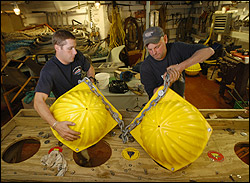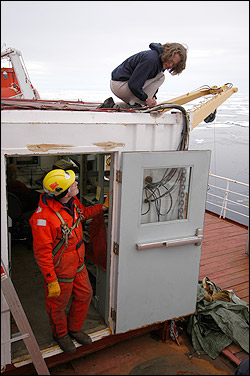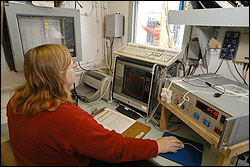Please note: You are viewing
the unstyled version of this website. Either your browser does not support CSS
(cascading style sheets) or it has been disabled. Skip
navigation.
Chris LinderAugust 10, 2005
We have been churning westward through annual ice, which is one-to-three foot thick sea ice that forms every year in the winter only to melt away again in the summer. The CTD crew has been sampling night and day, but still struggling with a mysterious problem with the data signal. Chief Scientist Sarah Zimmermann braved the chill rain today to separate some cables on top of the CTD control van. It was possible that there was some electrical interference causing the signal problems. The watch team will continue to monitor the problem very closely. While the CTDs were going up and down, the mooring crew was getting ready to put that long Beaufort Gyre Observing System mooring (the first of four they will be deploying, named simply "Mooring A") back in. Rick Krishfield spent the day downloading the previous year's data and replacing batteries in the instruments. Kris Newhall and John Kemp were making quite a racket down in the hold. They had set up a makeshift "float factory," complete with custom work bench, for replacing the corroded chains and connectors on the yellow floats that keep the mooring line taut underwater. The glass spheres and yellow "hard hat" covers would be reused, but John always prefers to redeploy the floats with new hardware. "It would probably be OK with this used stuff" John explained as he tossed another section of chain into a pile behind him. "But why take a chance on losing thousands of dollars worth of instruments because of a $4 shackle?" Kris and John also tested their acoustic release equipment, arguably the most important piece of the mooring since it allows us to get the instruments back. John tests the releases by opening them at depth so that there is no question they will work when we return next year. Tomorrow morning we will be back at the site of Mooring A, ready to put it back in the water for another year of data. It will be an all-day operation on the foredeck, so we're petitioning Poseidon for a day of sun. Last updated: October 7, 2019 | ||||||||||||||||||||||
Copyright ©2007 Woods Hole Oceanographic Institution, All Rights Reserved, Privacy Policy. | ||||||||||||||||||||||






